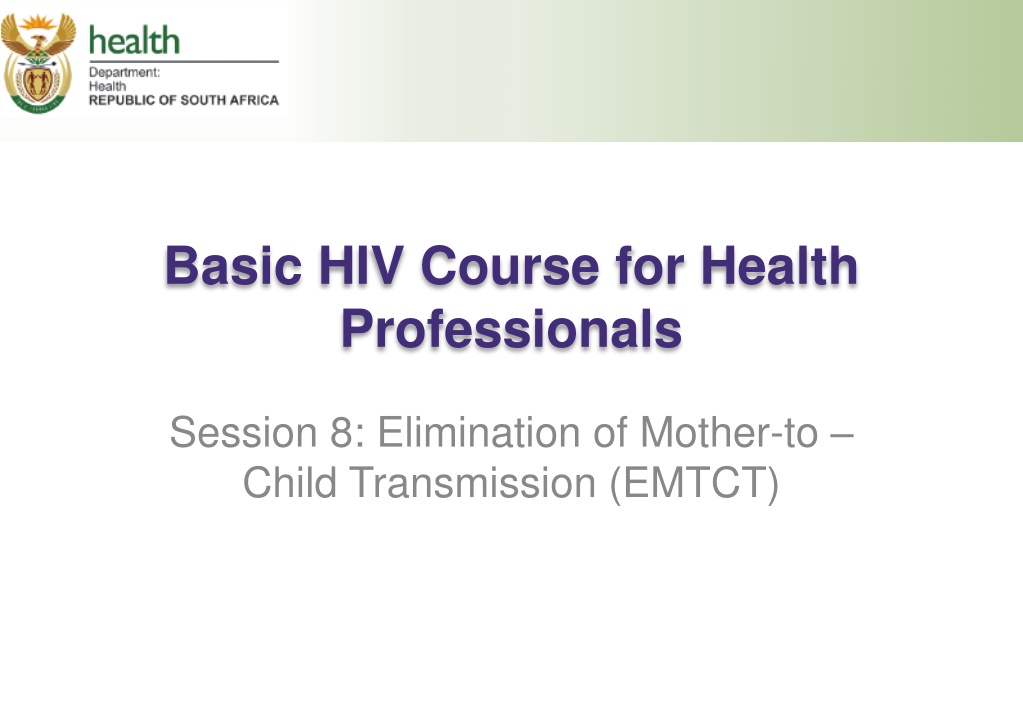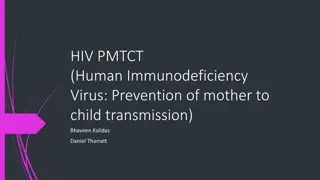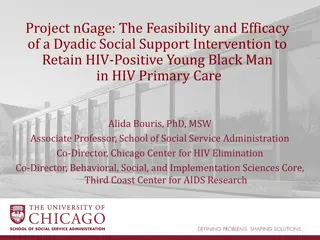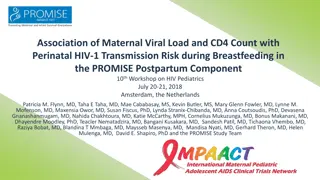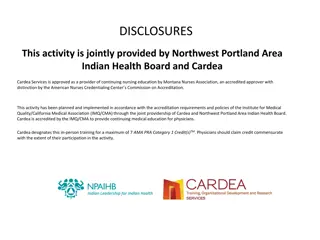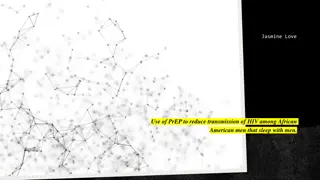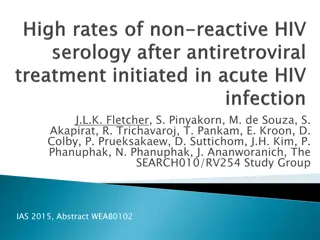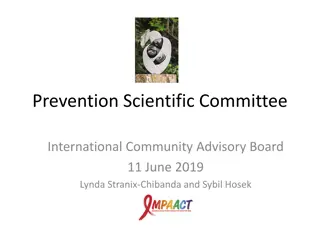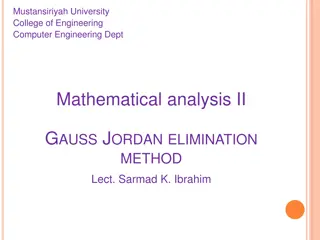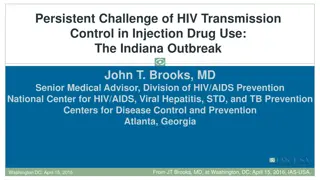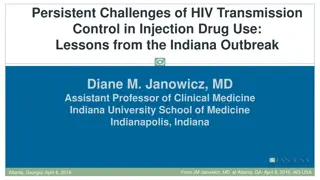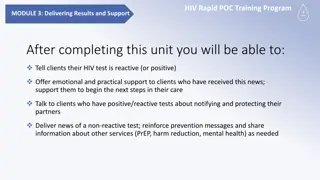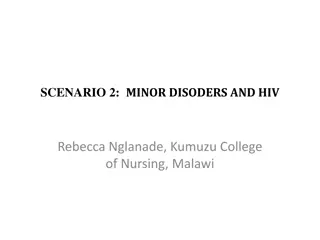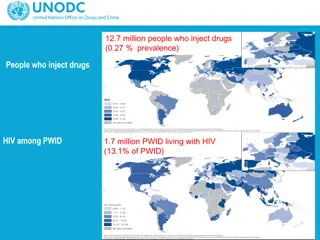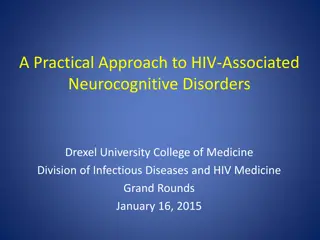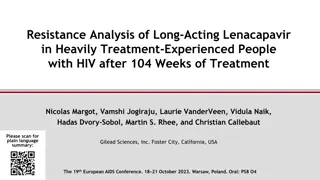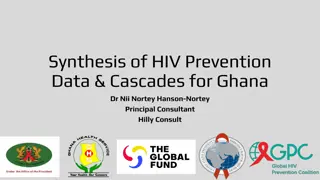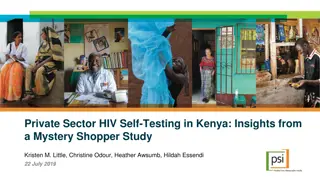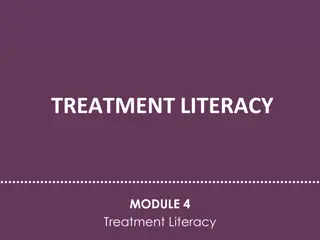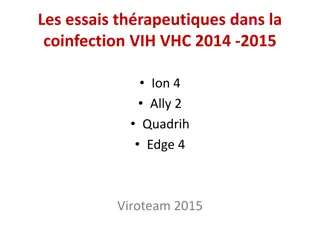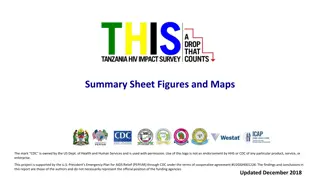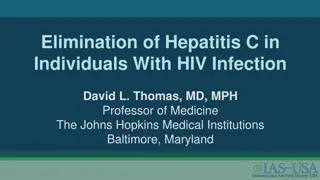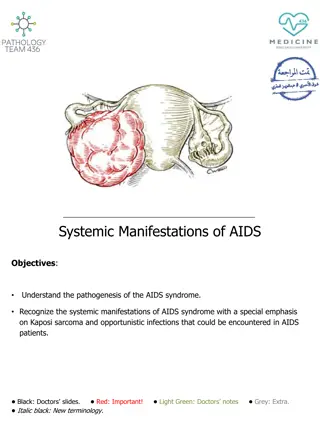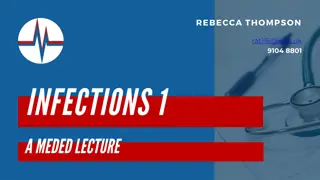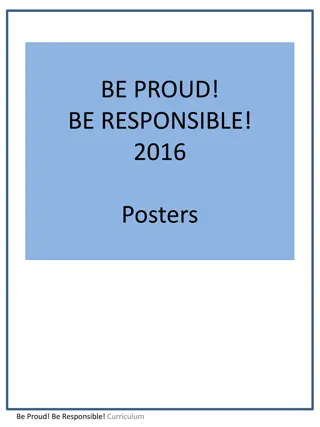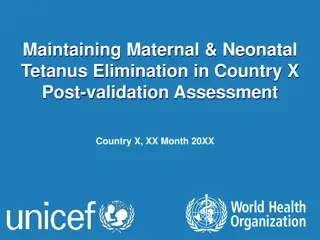Essential Information for Elimination of Mother-to-Child Transmission (EMTCT) in HIV
This session covers comprehensive guidance on managing HIV-infected pregnant women throughout preconception, antenatal, labor, and postnatal periods. It includes information on testing algorithms, ART initiation, viral load monitoring, prophylaxis for HIV-exposed infants, and the importance of breastfeeding. The aims of the EMTCT program focus on promoting the health of HIV-positive mothers and their infants, emphasizing adherence and virological suppression during pregnancy and breastfeeding. Key factors like the timing of ART initiation and safety considerations for ART regimens in pregnant women are highlighted. For detailed management, refer to specific pages in the participant manual.
Uploaded on Oct 06, 2024 | 0 Views
Download Presentation

Please find below an Image/Link to download the presentation.
The content on the website is provided AS IS for your information and personal use only. It may not be sold, licensed, or shared on other websites without obtaining consent from the author. Download presentation by click this link. If you encounter any issues during the download, it is possible that the publisher has removed the file from their server.
E N D
Presentation Transcript
Basic HIV Course for Health Professionals Session 8: Elimination of Mother-to Child Transmission (EMTCT)
Learning Objectives By the end of this session participants should be able to: Describe how to manage an HIV-infected pregnant woman during preconception, antenatal, labour and postnatal period Describe the testing algorithm for pregnant women Describe when to start ART in pregnant and breastfeeding women Describe screening and ART initiation for HIV-positive pregnant women Explain viral load monitoring for pregnant and breastfeeding women Explain prophylaxis in HIV exposed infants Describe the management of an HIV exposed infant Explain the importance of breastfeeding
Aims of EMTCT Programme Identify and promote the health of HIV-positive mothers and their HIV-exposed infants, including the diagnosis, management and prevention of opportunistic infections Reach out to all women before and during pregnancy, through labour and delivery, and through the postnatal period up to 18 months Attention must be paid to ensuring that pregnant and breastfeeding mothers are adherent and virologically suppressed during pregnancy and breastfeeding
Management of HIV-Infected Women Refer to pages 96 98 of your participant manual for guidance on how to manage HIV- infected pregnant women during: Preconception time Antenatal period Labour and Postnatal period
5 1. The Timing of ART Initiation Triple therapy ART should be initiated on the same day as HIV diagnosis. A women is pregnant for a finite period of time. The sooner she can initiate ART, the longer she will be on treatment before delivery. The longer the mother is on ART the better her chance to achieve viral suppression For every 1-week increase in the duration of ART during pregnancy, we can reduce the risk of MTCT by 10%!! Townsend, AIDS, 2008
6 3. Safety of the ART regimen (1) Same day ART initiation is desired in all pregnant and lactating women. However, contra-indications to starting ART, or to using individual drugs must always first be excluded. Remember that: DTG has potential for neural tube defects if used around the time of conception or in early pregnancy TDF is contra-indicated in renal disease TB with danger signs may result in TB IRIS if ART is initiated before TB has been diagnosed and TB treatment initiated
7 When to Start ART in Pregnant and Breastfeeding Women ART with 3 safe drugs should always be used and preferably be administered as a fixed dose combination (one tablet once a day) Recommended regimens are: Tenofovir, emtricitabine and efavirenz (TEE), or Tenofovir, lamivudine, and dolutegravir (TLD) EFV remains a safe and effective regimen for any pregnant or breastfeeding woman However, dolutegravir, has some additional advantages over efavirenz, namely: improved tolerability, a higher barrier to resistance, few drug interactions, and DTG achieves viral suppression more rapidly Therefore, if suitable and available, DTG is the preferred third drug in the ART regimens of all pregnant and breastfeeding women, but particularly in women presenting late into antenatal care, and those who have previously been exposed to ART.
8 3. Safety of the ART regimen (2) Dolutegravir Whilst DTG has many advantages over EFV, recent data from Botswana indicated a potential safety signal for the risk of neural tube defects (NTDs) in women conceiving on a DTG- based regimen. Therefore, caution should be exercised in women wanting to conceive, women not on reliable contraception, and pregnant women in the 1st trimester. All women need to be appropriately counselled on the risks and benefits of DTG and allowed to make an informed choice. Should she opt to use DTG despite recommendations to the contrary by her HCW, these should be documented in writing. Efavirenz remains a safe and effective alternative agent if DTG is not suitable
Eligibility Criteria for Pregnant and Breastfeeding Women POPULATION WHEN TO START Pregnant and breastfeeding women COMMENTS Emphasise exclusive breastfeeding for the first 6 months, with complementary feeding only from 6 months and breastfeeding continued until 12 months Initiate lifelong ART in all pregnant or breastfeeding women on the same day of diagnosis regardless of CD4 count All unbooked women who test positive during labour should be given prophylactic ART during labour and initiated on lifelong ART before being discharged
Screening and ART Initiation for HIV Positive Pregnant Women
Screen for Neuropsychiatric Illness (1) Active Psychiatric Illness: If she has ACTIVE/UNTREATED psychiatric disorder: DO NOT initiate TDF Replace EFV with either NVP or LPVr Provide AZT 300mg bd (if Hb 7g/dl) HIGH RISK PREGNANCY Urgently refer/discuss telephonically Initiate alternative lifelong triple drug regimen (NVP or LPV/r, dependant on CD4 count, plus TDF and 3TC) Screen and refer any psychiatric disorder
Screen for Renal Disease (2) TDF contra-indicated in people with renal dysfunction Renal disease uncommon in HIV infected pregnant women Identify women at increased risk of renal disease at first visit Replace TDF with ABC if suspected renal disease
Screen for Renal Disease (3) If patient history suggests renal disease, replace TDF with ABC same day and review Creatinine result after 7 days Do not initiate TDF same day if risk factors present Send for creatinine test: Review in 1 week Creatinine normal: INITIATE TDF Creatinine 85 mol/L = HIGH RISK PREGNANCY Continue ABC
3. Screen for TB (4) TB is a major cause of maternal mortality and TB with danger signs is an indication for deferring ART due to the risk of IRIS. Therefore, TB screening should be done prior to ART initiation, and at every visit during antenatal care, at labour and delivery, and in the period after birth. However, a recent study found that the sensitivity of the TB symptom screen is reduced in pregnancy. As a result, a significant number of pregnant women have active TB, but do not have TB symptoms. If a TB symptom screen alone were to be used, a significant number of TB cases in pregnant women would be missed. For this reason, a TB GXP should be done for the following women, regardless of whether they have TB symptoms or not: All pregnant women with a new HIV diagnosis All known HIV + women with a new pregnancy diagnosis
Viral Load Monitoring During Pregnancy and Breastfeeding
Woman Already on ART 3 months and Conceives (1) Viral Load to be repeated on the day of pregnancy confirmation Regardless of when last done Need to know woman is virally suppressed Review result within ONE WEEK If virally suppressed: Continue on current regimen Provide adherence counselling
Women who where previously on ART (2) Known HIV-positive women, who are not currently on ART, but are ART exposed (e.g. previous PMTCT, or ART discontinued) Do VL before re-starting ART (but do not wait for the result before starting ART) Repeat VL in one month
VL Monitoring and Response (1) Viral Load monitoring : Confirms good adherence and viral suppression Timeously detects factors negatively affecting VL The following code should be on the lab form of every VL in a pregnant or breastfeeding women, so electronic gatekeeping rules (EGK) do not lead to sample rejection. C#PMTCT
Assessing and Managing an Elevated VL VL suppression is defined as less than 50 copies/ml Any VL > 50 c/mL is a medical emergency and requires attention: You must Respond to the result !! If you Measure the VL 1. A thorough assessment if VL > 50 c/ml 2. Implementation of interventions 3. Repeat VL testing to confirm VL re-suppression
VL Monitoring and Response (2) VL Monitoring Schedule during Antenatal Care New HIV diagnosis HIV & initiated on ART for the first time: Do 1st VL at 3m on ART If suppressed, repeat VL at delivery Known HIV-positive women already on ART: VL at first/booking visit in ANC If suppressed: Repeat VL at delivery. Known HIV-positive women, currently not on ART, but are ART exposed (e.g. previous PMTCT, or ART discontinued) Do VL before re-starting ART (but don t await results before starting ART) Repeat VL in one month If more than one log drop in VL - continue & repeat VL in 2m If suppressed, repeat VL at delivery
VL Monitoring and Response (3) VL Monitoring Schedule During and After Birth VL at delivery, to determine response to ART in ANC prophylaxis for the HIV exposed infant (HEI) re-calibrating time points for maternal VLs during BF VL at 6m after delivery, regardless of BF status VL 6-monthly during BF, aligned to the 6m, 12m and 18m well child visits
VL Monitoring for First-Line Regimen in Pregnant and Breastfeeding Women (2) Always check for Hep B before stopping TDF If a pregnant woman is diagnosed with HBsA positive, neonate must receive Hep B immunoglobulin and Hep B immunisation at birth and then continue with routine immunisations as per protocol Do VL test for all HIV positive women (known positive on ART) at first ANC visit and at labour/delivery when baby gets birth PCR test done
Second Line Regimen for Late Adolescents and Adults Second line regimen: adolescents 15 years and adults First line virological failure Drugs Comments If non-adherent, address causes of non-adherence Failing on TDF/ 3TC or FTC/NVP or EFV Switch to AZT/3TC* + DTG If the VL >1000 copies/mL at any point, intensify adherence and repeat VL in 2 months Failing on AZT/3TC/NVP or EFV If VL remains at >1000 copies/mL after 2 months, then switch to second line regimen * All patients switching off TDF should have their Hepatitis B status checked Switch to TLD Dyslipidaemia (total cholesterol >6 mmol/L) or diarrhoea associated with LPV/r Anaemia and renal failure Switch LPV/r to ATV/r Switch to ABC
Small Group Discussion Discuss strategies to manage breastfeeding women with unsuppressed VL
Management of Breastfeeding Women with Unsuppressed VL (1) If an HIV positive breastfeeding woman has a detectable viral load > 400 copies/ml: Provide active clinical management, close follow-up Do an age appropriate infant HIV test Continue infant prophylactic NVP and AZT until maternal VL is < 400 If child is < 6 months, reemphasise importance of exclusive breastfeeding (Up)-referral to experienced HIV clinician in cases where adherence counselling does not result in rapid viral suppression
Management of Breastfeeding Women with Unsuppressed VL (2) Women who are already on ART: repeat 6 monthly if <1000 copies repeat after ONE MONTH if >1000 copies Women newly initiated on ART: first viral load at 3 months on treatment if adequate response, repeat at 6 months on treatment and then 6 monthly if <1000 copies if >1000 copies, repeat after ONE month with step up adherence counselling
Co-trimoxazole Prophylaxis in HIV- Exposed Infants All HIV-positive and HIV-exposed infants must receive Co-trimoxazole prophylaxis from 4-6 weeks of age Co-trimoxazole (sulfamethoxazole/trimethoprim) given once daily Refer to pages 105-106 of your participant manual for guidance on prescribing CTP
Recommended Dosing for Prophylactic Co-trimoxazole for Infants and Children (1) Age or weight of child sulfamethoxaz ole/ trimethoprim ml) Dose Suspension (200 mg SMX/ 40mg TMP/ 5 Single strength tablet (400 mg SMX/80mg TMP) tablet Double strength tablet (800 mg SMX/160 mg TMP) <6 weeks or<5 kg 6 weeks 5 years or 5 15kg 6-14 years or 15 30kg 100mg SMX/20 mg TMP 200mg SMX/40 mg TMP 400mg SMX/80 mg TMP 2.5 ml 5 ml tablet 10 Ml 1 tablet tablet >14 years or >30 kg 800mg SMX/160 mg TMP 2 tablets 1 tablet
Recommended Dosing for Prophylactic Co-trimoxazole for Infants and Children (2) Co-trimoxazole can cause erythema multiforme and Stevens-Johnson syndrome If this occurs, stop the co-trimoxazole Use Dapsone in Co-trimoxazole intolerant patients Recommended dose is 2 mg/kg/day or 4 mg/kg/week Maximum daily dose is 100 mg (1 tablet)
Care of All Infants in the Immediate Post-Delivery Period Skin-to-skin contact with mother as soon as possible Initiate exclusive breastfeeding
Care of HIV-Exposed Infants in the Immediate Post-Delivery Period (1) Initiate infant prophylaxis Infant birth PCR Start prophylaxis immediately or soon after birth Counsel re: adherence to maternal ART and infant prophylaxis Vaccinate infants per EPI schedule Give BCG to all infants, unless: HIV exposed and symptomatic or mother has active TB disease and has had <2months of TB treatment at time of birth If mother has active TB disease at birth and has been on treatment for <2 months, screen exposed infants for congenital TB Test ALL HIV-exposed infants for HIV at birth
Care of HIV-Exposed Infants in the Immediate Post- Delivery Period (2) ART prophylaxis given at birth to all HIV-exposed infants is effective in reducing MTCT whether maternal ART is received or not Give infants born to HIV-positive women daily NVP for 6 weeks - unless circumstances warrant 12 weeks of NVP or NVP plus AZT Breastfeeding mother diagnosed HIV positive > 72 hours after delivery or Mother on ART with latest VL > 1000 copies/ml during breastfeeding. - NVP for minimum of 12 weeks. Stop after confirmation of VL being less than 1000 c/ml - AZT twice daily for 6 weeks Give abandoned babies NVP prophylaxis immediately until HIV-exposure status has been determined, using HIV antibody test Perform EPI-scheduled visits for vaccination at 6, 10 and 14 weeks at EPI clinic and a routine health check First postnatal visit for the infant is scheduled for day 3, and should occur within 6 days of life
Exclusive Breastfeeding (1) Initiate breastfeeding within hour of birth with skin to skin contact Reinforce EXCLUSIVE breastfeeding - no water, tea, or food except prescribed medication for 6 months Complementary feeding from six months Demonstrate correct positioning and attachment to breast to reduce risk of cracked/bleeding nipples or breast infection, which can increase risk of HIV
Exclusive Breastfeeding (2) Advice about feeding on demand 8-12 times (both breasts) every 24 hours Remind to alternate breasts when starting to feed Teach mother to wake baby at night if enough feeds haven t occurred Advice about health hazards of bottles, dummies, artificial teats, and cups with spouts Demonstrate how to express milk and feed with cup if breast problems occur
Activity: Benefits and Risks of Exclusive Breastfeeding
Benefits of Exclusive Breastfeeding Babies get best nutrients from mother s milk because it is not contaminated Prevents many diseases including diarrhoea and chest infections Reduces mother s risk of breast cancer, reduces weight gained during pregnancy, supports maternal infant bond and readily available
Risks of Exclusive Breastfeeding Mother may transmit HIV to baby Risk increases when mother has high VL, cracked or bleeding nipples or a breast infection Mother should go to doctor if sores, lumps or pain in breast or if baby has mouth sores Mother can still express and feed milk to baby with a cup if milk does not contain blood Risks of HIV transmission during exclusive breastfeeding reduce when: compared to overall health of infant if formula or mix fed VL is reduced with effective ART
Correct Positioning Baby s whole-body faces mother (tummy to tummy) with nose to mother s breast Baby supported by mother s arm Mother comfortable, back straight
Correct Attachment Baby s chin touches breast Baby s mouth open wide, lower lip curled forward More areola above upper lip, less areola below lower lip Baby takes slow, deep sucks, with pauses Baby relaxed, content, satisfied after feeding Mother does not feel nipple pain
Antiretroviral Treatment and Breastfeeding ART decreases amount of HIV in blood and breast milk, significantly reducing chances of HIV being transmitted to the baby If mother already on lifelong ART, she should continue treatment during breastfeeding In addition, give baby prophylaxis daily for 6 weeks after birth or longer if mother has high VL that is managed
Stopping Breastfeeding for Women with HIV Mother should continue lifelong ART Breastfeeding is recommended until the baby is 2 years Encourage mothers exclusively breastfeed infants during first 6 months of life Introduce complementary foods from 6 months Breastfeeding may continue to 2 years or more
Informed decision for Replacement Infant Feeding (1) Able to: provide sufficient infant formula to safely exclusively formula feed for first 6 months of life prepare infant formula hygienically and correctly provide adequate, appropriately constituted formula feeds frequently enough to provide adequate nutrition to ensure optimal infant growth and development Safe water and sanitation assured at household level and community
Informed decision for Replacement Infant Feeding (2) Choose a breast milk substitute (commercial infant formula milk product) that is appropriate for infant s age and circumstances: Infants weighing <2 kg should receive a special low birth weight formula until infant weighs at least 2 kg Thereafter, give infant formula for a full-term infant A soy protein based formula should not be given to an infant <2kg
Any Questions? Thank you!
